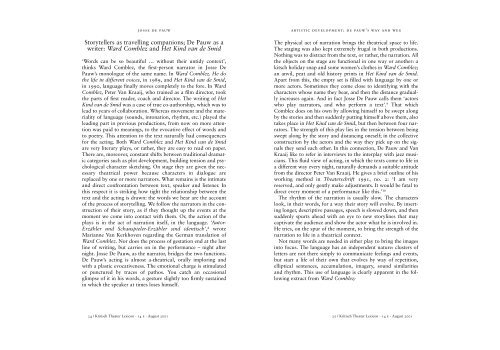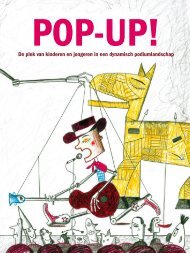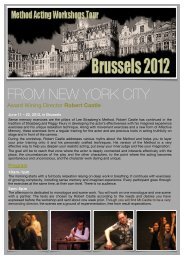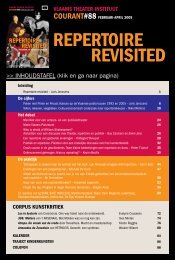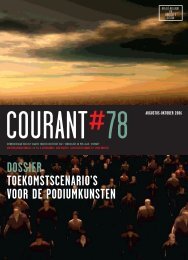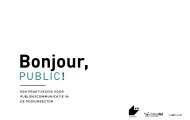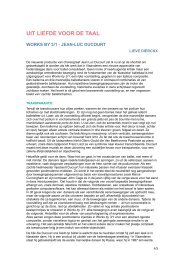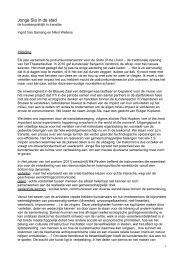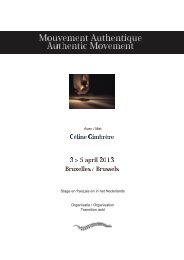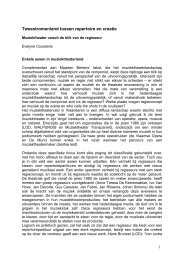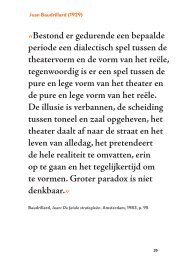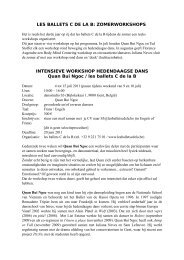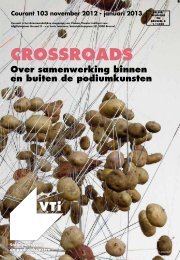Create successful ePaper yourself
Turn your PDF publications into a flip-book with our unique Google optimized e-Paper software.
josse de pauw<br />
Storytellers as travelling companions; <strong>De</strong> <strong>Pauw</strong> as a<br />
writer: Ward Comblez and Het Kind van de Smid<br />
‘Words can be so beautiful … without their untidy context’,<br />
thinks Ward Comblez, the first-person narrator in Josse <strong>De</strong><br />
<strong>Pauw</strong>’s monologue of the same name. In Ward Comblez. He do<br />
the life in different voices, in 1989, and Het Kind van de Smid,<br />
in 1990, language finally moves completely to the fore. In Ward<br />
Comblez, Peter Van Kraaij, who trained as a film director, took<br />
the parts of first reader, coach and director. The writing of Het<br />
Kind van de Smid was a case of true co-authorship, which was to<br />
lead to years of collaboration. Whereas movement and the materiality<br />
of language (sounds, intonation, rhythm, etc.) played the<br />
leading part in previous productions, from now on more attention<br />
was paid to meanings, to the evocative effect of words and<br />
to poetry. This attention to the text naturally had consequences<br />
for the acting. Both Ward Comblez and Het Kind van de Smid<br />
are very literary plays, or rather, they are easy to read on paper.<br />
There are, moreover, constant shifts between traditional dramatic<br />
categories such as plot development, building tension and psychological<br />
character sketching. On stage they are given the necessary<br />
theatrical power because characters in dialogue are<br />
replaced by one or more narrators. What remains is the intimate<br />
and direct confrontation between text, speaker and listener. In<br />
this respect it is striking how tight the relationship between the<br />
text and the acting is drawn: the words we hear are the account<br />
of the process of storytelling. We follow the narrators in the construction<br />
of their story, as if they thought up the events at the<br />
moment we come into contact with them. Or, the action of the<br />
plays is in the act of narration itself, in the language. ‘Autor-<br />
Erzähler und Schauspieler-Erzähler sind identisch’, 8 wrote<br />
Marianne Van Kerkhoven regarding the German translation of<br />
Ward Comblez. Nor does the process of gestation end at the last<br />
line of writing, but carries on in the performance – night after<br />
night. Josse <strong>De</strong> <strong>Pauw</strong>, as the narrator, bridges the two functions.<br />
<strong>De</strong> <strong>Pauw</strong>’s acting is almost a-theatrical, orally imploring and<br />
with a plastic evocativeness. The emotional charge is stimulated<br />
or punctured by traces of pathos. You catch an occasional<br />
glimpse of it in his words, a gesture slightly too firmly sustained<br />
in which the speaker at times loses himself.<br />
24 / Kritisch Theater Lexicon - 14 e - August 2001<br />
artistic development: de pauw’s way and weg<br />
The physical act of narration brings the theatrical space to life.<br />
The staging was also kept extremely frugal in both productions.<br />
Nothing was to distract from the text, or rather, the narration. All<br />
the objects on the stage are functional in one way or another: a<br />
kitsch holiday snap and some women’s clothes in Ward Comblez;<br />
an anvil, peat and old history prints in Het Kind van de Smid.<br />
Apart from this, the empty set is filled with language by one or<br />
more actors. Sometimes they come close to identifying with the<br />
characters whose name they bear, and then the distance gradually<br />
increases again. And in fact Josse <strong>De</strong> <strong>Pauw</strong> calls them ‘actors<br />
who play narrators, and who perform a text’. 9 That which<br />
Comblez does on his own by allowing himself to be swept along<br />
by the stories and then suddenly putting himself above them, also<br />
takes place in Het Kind van de Smid, but then between four narrators.<br />
The strength of this play lies in the tension between being<br />
swept along by the story and distancing oneself; in the collective<br />
construction by the actors and the way they pick up on the signals<br />
they send each other. In this connection, <strong>De</strong> <strong>Pauw</strong> and Van<br />
Kraaij like to refer in interviews to the interplay with jazz musicians.<br />
This fluid view of acting, in which the texts come to life in<br />
a different way every night, naturally demands a suitable attitude<br />
from the director Peter Van Kraaij. He gives a brief outline of his<br />
working method in Theaterschrift 1991, no. 2: ‘I am very<br />
reserved, and only gently make adjustments. It would be fatal to<br />
direct every moment of a performance like this.’ 10<br />
The rhythm of the narration is usually slow. The characters<br />
look, in their words, for a way their story will evolve. By inserting<br />
longer, descriptive passages, speech is slowed down, and then<br />
suddenly spurts ahead with an eye to new storylines that may<br />
captivate the audience and show the actor what he is involved in.<br />
He tries, on the spur of the moment, to bring the strength of the<br />
narration to life in a theatrical context.<br />
Not many words are needed in either play to bring the images<br />
into focus. The language has an independent nature: clusters of<br />
letters are not there simply to communicate feelings and events,<br />
but start a life of their own that evolves by way of repetition,<br />
elliptical sentences, accumulation, imagery, sound similarities<br />
and rhythm. This use of language is clearly apparent in the following<br />
extract from Ward Comblez:<br />
25 / Kritisch Theater Lexicon - 14 e - August 2001


